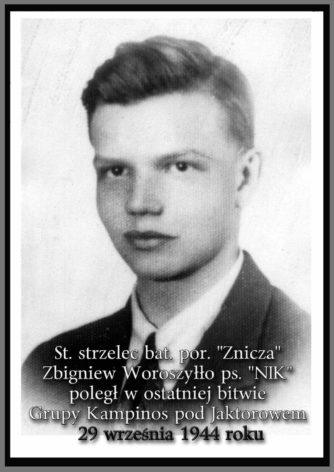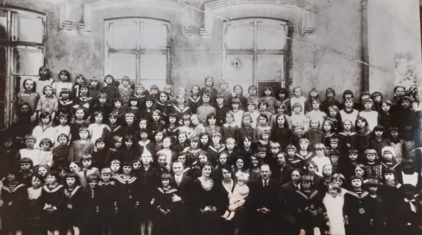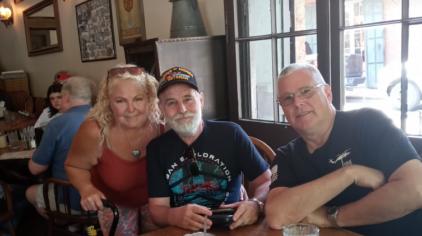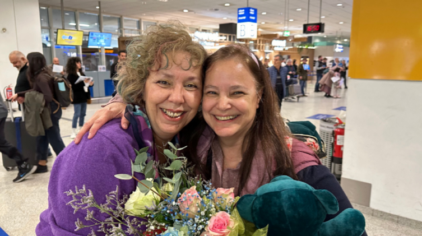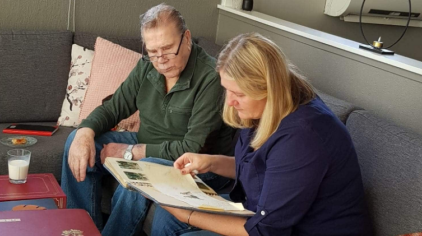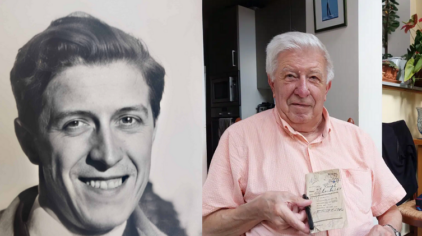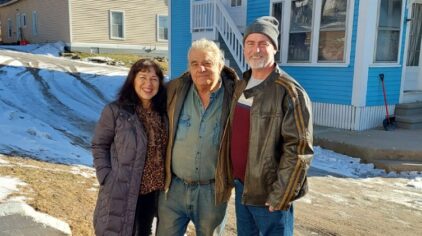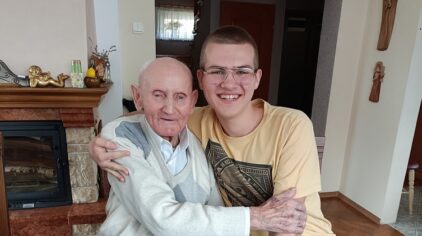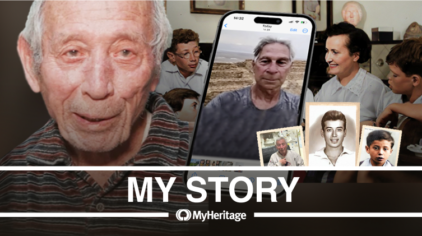Wzruszjący WYWIAD: Pan Krzysztof Wacławski ku czci swoich przodków – Bohaterów II Wojny Światowej
- Od Katie
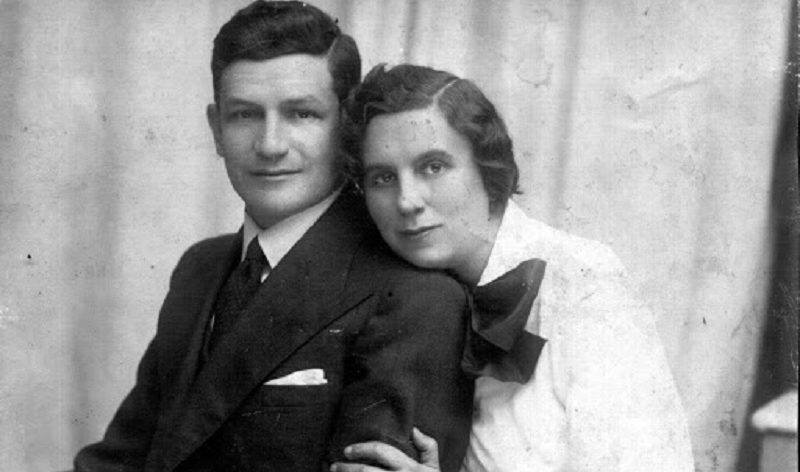

This interview with Mr. Krzysztof Wacławski was conducted in honor of his cousin’s Grandmother and Grandfather, who during the Second World War saved a Jewish girl by accepting her into their home as their daughter. Read in the interview what role Krzysztof played in honoring this story, and learn about touching and heartwarming details!
MH: Please introduce yourself, how old are you, what do you do on a daily basis, do you have a family?
PK W : My name is Krzysztof Wacławski, I am 67 years old and I am retired.
I am an electronics engineer by profession and I have worked at the Institute of Computer Science at the Faculty of Electronics of the Warsaw University of Technology for over 45 years. I have been married to Teresa for 39 years. We have two married daughters Beata with Łukasz and Joanna with Marcin, and eight grandchildren: 3 granddaughters and 5 grandchildren, four with each daughter (Karolina, Dorota, Natalia, Stanisław, Mateusz, Adam, Wojciech and Jakub) aged 11 to 2 years). We are currently meeting our grandchildren and it is our joy that we can participate in the growth of the next generations of our family. I like reading books, visiting theaters and participating in interesting concerts, as well as picking mushrooms.
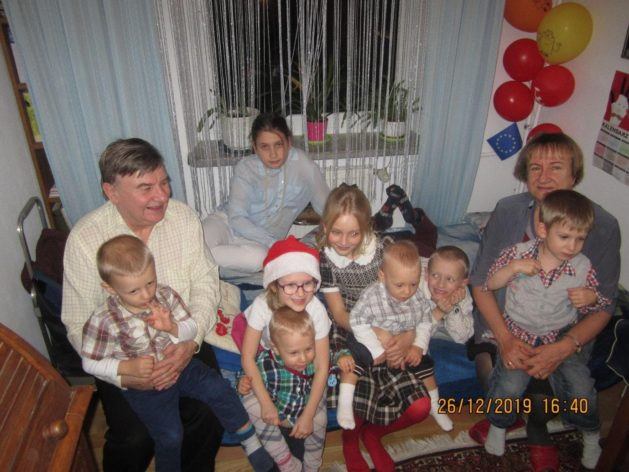 Grandparents with eight grandchildren." width="629" height="472" />
Grandparents with eight grandchildren." width="629" height="472" />Grandparents with eight grandchildren.
MH: Please tell us about the story of your great aunts, for whom we decided to interview you in the first place?
PK W: Aleksandra Seweryna Woroszyłło née Wacławska was born on November 23, 1903 in Warsaw. It was the birth sister of Feliks Wacławski, who was my grandfather and the father of my father Tadeusz.
Kazimierz Zygfryd Woroszyłło was born on February 25, 1901 in the town of Jeziorna near Warsaw.
My great-aunt Aleksandra Wacławska married Kazimierz Woroszyłło on June 1, 1936 in Vilnius. She was his second wife. The son of Kazimierz from his first marriage, Zbigniew, also lived with them. They lived in Warsaw.
Kazimierz and his wife Aleksandra saved Elżbieta, the child of Artur Lewin and Eugenia Szajn-Lewin, when the ghetto in Warsaw was created. From 1942 until the outbreak of the Warsaw Uprising in August 1944, they lived with their foster daughter in Warsaw at 2/4 Bednarska Street, apartment 14. Ela had a false baptism certificate with the name Basia. She made friends with Zbyszek who was 16 at the time, and she was four. They had fun together. Unfortunately, Zbyszek died in the last days of the Warsaw Uprising on September 29 near Jaktorów. To this day, his grave has not been found.
In 1945, Kazimierz Woroszyłło got into a quarrel with the Russians and was sent to Siberia by the Soviets. In 1947, he escaped on a stolen horse with the brother of Marian Spychalski, later Polish Marshal and Minister of National Defense. The Russians released a series of automatic weapons and hit Brother Marian, who was sitting second on the horse. Kazimierz only realized when he stopped that Spychalski’s brother was dead. For many days he made his way to Poland. When he got off the train in Mińsk Mazowiecki, he was so weak that the wind was knocking him over. When he stood on the threshold of his brother-in-law Feliks Wacławski’s house in Praga, on Targowa Street, where his wife Aleksandra lived, they did not recognize him because he was so exhausted. Then they lived together in Warsaw at Wery Kostrzewy Street. He died on October 8, 1965.
His wife, Aleksandra Woroszyłło, lived alone until 1980 and for the last years I took care of her and helped in everyday matters. She died on May 30, 1980.
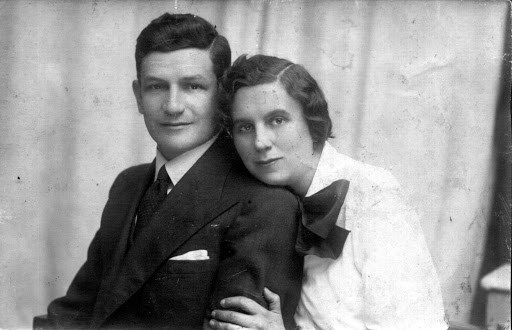 Aleksandra and Kazimierz Woroszyłło" width="631" height="407" />
Aleksandra and Kazimierz Woroszyłło" width="631" height="407" />Aleksandra and Kazimierz Woroszyłło
Elżbieta, in those years Basia was treated by her grandparents as her own daughterand to this day she mentions that she was well brought up. After the Warsaw Uprising, they escaped with Aleksandra to Pruszków, where they lived with the farmers and ate potatoes, onions and cabbage, and to this day it is her favorite food, those flavors from a difficult childhood. Elżbieta Eugenia’s mother died of wounds in a bombed apartment on Puławska Street, where she was hiding with her family during the Warsaw Uprising. I found her grave at the Jewish cemetery at Okopowa Street in Warsaw. During Elżbieta’s stay in Warsaw in 2018, we visited this grave, and Elżbieta remembered from the time of the war that next to it is the grave of her mother’s twin sister Maria Dawid Prair, who was also in this bombed apartment and died of serious wounds.
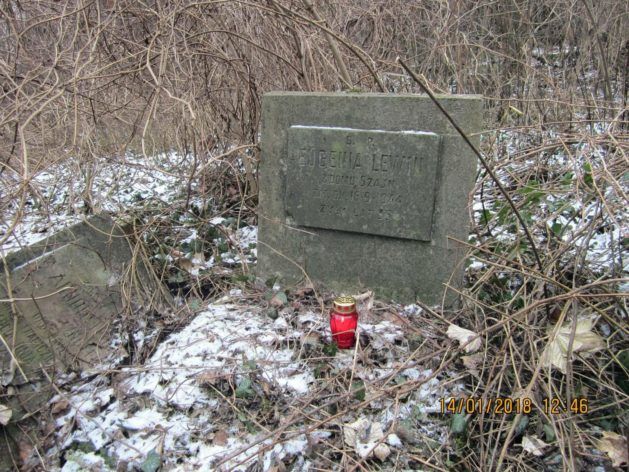 Eugenia Lewin’s grave" width="629" height="472" />
Eugenia Lewin’s grave" width="629" height="472" />Eugenia Lewin’s grave
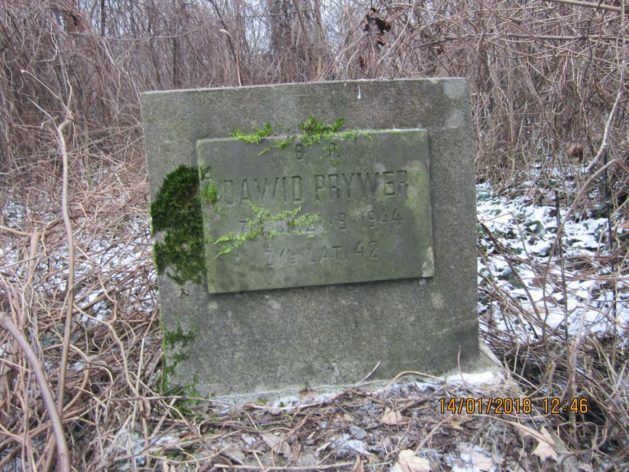 The grave of David Priver" width="629" height="472" />
The grave of David Priver" width="629" height="472" />The grave of David Priver
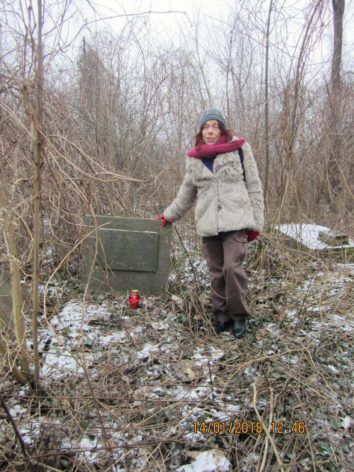 Elizabeth at the grave of Eugenia’s mother" width="437" height="583" />
Elizabeth at the grave of Eugenia’s mother" width="437" height="583" />Elizabeth at the grave of Eugenia’s mother
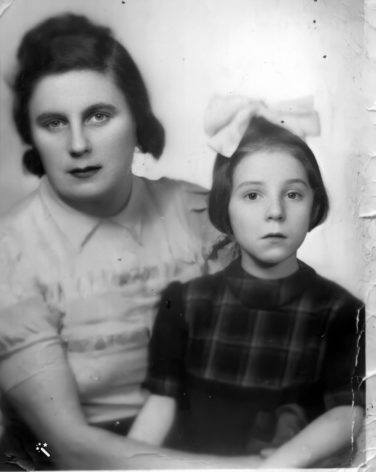 Elżbieta Lewin with Aleksandra Woroszyłło, foster mother." width="477" height="599" />
Elżbieta Lewin with Aleksandra Woroszyłło, foster mother." width="477" height="599" />Elżbieta Lewin with Aleksandra Woroszyłło, foster mother.
Elżbieta Lewin stayed with my grandparents until 1946. Then, with their father Artur and his new fiancée, and later wife Irena Kaczmarska, they left for Łódź, where they had lived until 1939 and met the surviving family at Piotrkowska Street. After that, they tried to go to Mexico, but finally decided on better living conditions in France, in Paris, where they lived. Eli Iza’s half-sister was born in Paris.
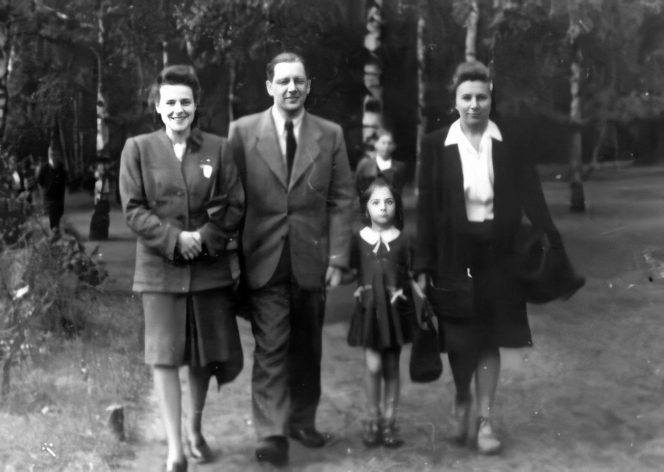 In 1946, Elżbieta’s farewell goes from the right to Aleksandra Woroszyłło, Elżbieta and her father Artur Lewin, and Irena Kaczmarska." width="734" height="522" />
In 1946, Elżbieta’s farewell goes from the right to Aleksandra Woroszyłło, Elżbieta and her father Artur Lewin, and Irena Kaczmarska." width="734" height="522" />In 1946, Elżbieta’s farewell goes from the right to Aleksandra Woroszyłło, Elżbieta and her father Artur Lewin, and Irena Kaczmarska.
Aleksandra Woroszyłło kept in touch by mail with Artur Lewin and Elżbieta when they lived in Paris. When she had problems, they supported her in various ways.
MH: Your commitment and willingness to honor this story was another reason for us to publicize this story, please tell me about the medal and diploma from the Yad Vashem institute and the role you played there?
PKW:I strove to honor Aleksandra and Kazimierz Woroszyłło with the medal of the Righteous Among the Nations. I have been doing these efforts for 13 years. I found Eugenia’s sister Maria Line in Tel Aviv. But she could not testify because she was already elderly and had senile dementia. In the end, Elżbieta Lewin was ready for this decision and gave a testimony. She told me she needed a long time to deal with these difficult memories. Finally, in the fall of 2016, I received a message from the Yad Vashem Institute in Jerusalem that at the session on September 13, 2016, Aleksandra and Kazimierz Woroszyłło were recognized as Righteous Among the Nations. I also received the address of Elizabeth Lewin in Los Angeles. I happily found her phone on the internet and called her on the eve of 2016. We talked for about an hour and it was as if we knew each other perfectly. Elżbieta remembers Polish perfectly well and has a great memory. She told me about many interesting events from the past that I did not know about. It was a lovely conversation. She emphasized that it was thanks to my great-aunt and her husband that she was alive and well.
The ceremony of presenting the diploma and medal in the representative hall of the Royal Castle in Warsaw took place on January 15, 2018. It was a beautiful ceremony and a great honor for me.
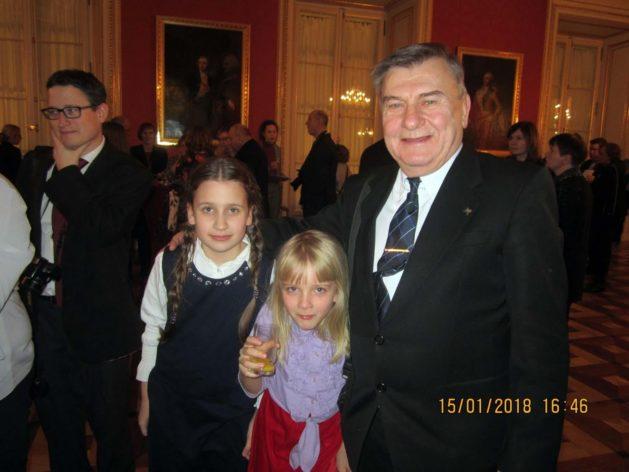 Krzysztof Wacławski with his eldest granddaughters Karolina and her cousin Dorotka at the ceremony." width="772" height="579" />
Krzysztof Wacławski with his eldest granddaughters Karolina and her cousin Dorotka at the ceremony." width="772" height="579" />Krzysztof Wacławski with his eldest granddaughters Karolina and her cousin Dorotka at the ceremony.
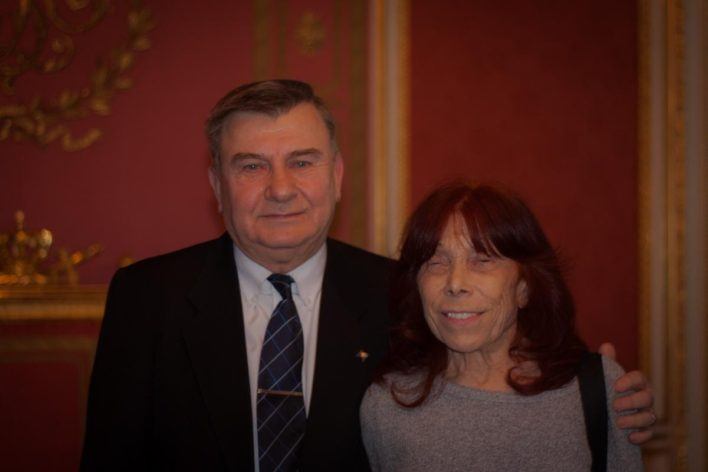 Krzysztof Wacławski with rescued Elżbieta Lewin" width="839" height="559" />
Krzysztof Wacławski with rescued Elżbieta Lewin" width="839" height="559" />Krzysztof Wacławski with rescued Elżbieta Lewin
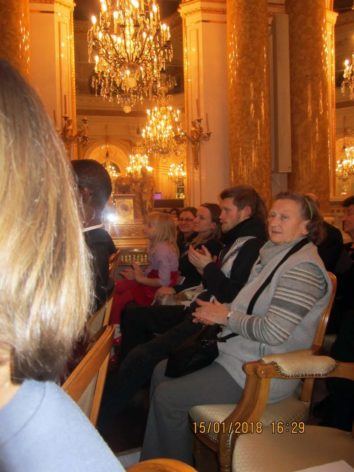 Daughters Beata and Joanna and granddaughter Dorotka in the Royal Castle (in the background)" width="435" height="580" />
Daughters Beata and Joanna and granddaughter Dorotka in the Royal Castle (in the background)" width="435" height="580" />Daughters Beata and Joanna and granddaughter Dorotka in the Royal Castle (in the background)
 Krzysztof with rescued Elżbieta Lewin and her partner Roki." width="524" height="699" />
Krzysztof with rescued Elżbieta Lewin and her partner Roki." width="524" height="699" />Krzysztof with rescued Elżbieta Lewin and her partner Roki.
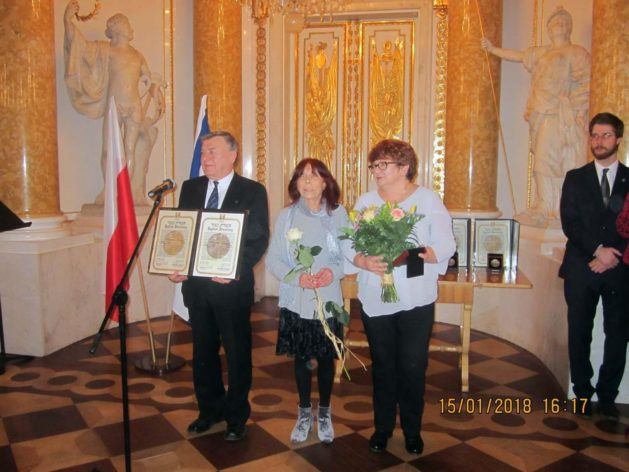 Krzysztof Wacławski with a diploma and rescued Elżbieta Lewin." width="756" height="567" />
Krzysztof Wacławski with a diploma and rescued Elżbieta Lewin." width="756" height="567" />Krzysztof Wacławski with a diploma and rescued Elżbieta Lewin.
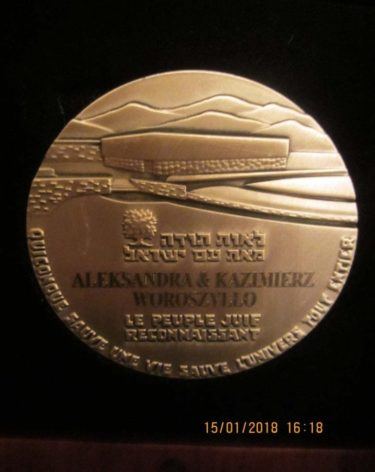 Medal for Aleksandra and Kazimierz Woroszyłło." width="573" height="722" />
Medal for Aleksandra and Kazimierz Woroszyłło." width="573" height="722" />Medal for Aleksandra and Kazimierz Woroszyłło.
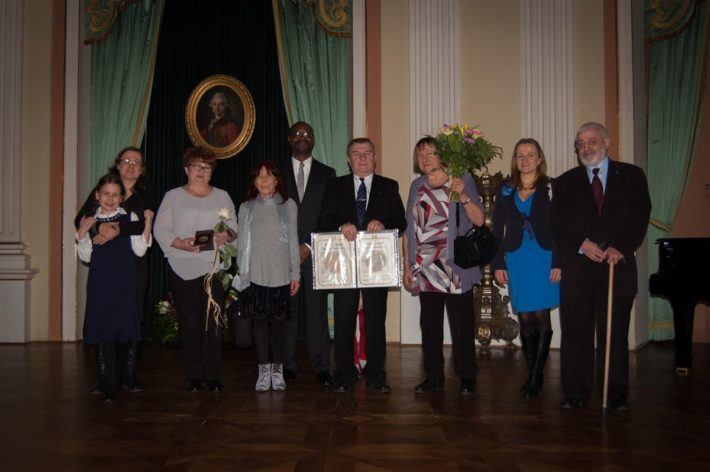 Krzysztof Wacławski with his wife Teresa, daughters Beata and Joanna, and family at the ceremony at the Royal Castle" width="874" height="581" />
Krzysztof Wacławski with his wife Teresa, daughters Beata and Joanna, and family at the ceremony at the Royal Castle" width="874" height="581" />
Krzysztof Wacławski with his wife Teresa, daughters Beata and Joanna, and family at the ceremony at the Royal Castle
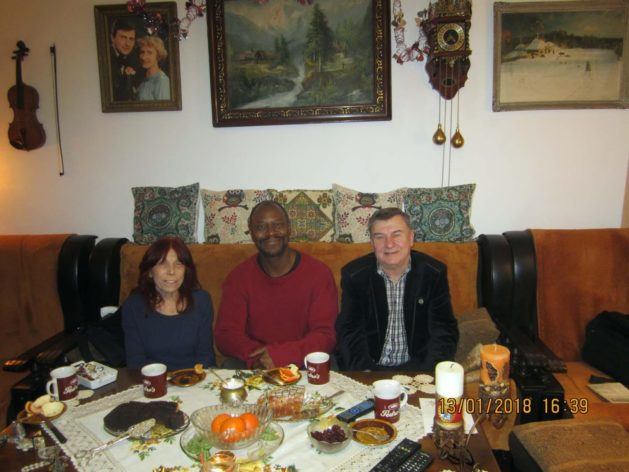 Rescued Elżbieta Lewin with her partner Roki at my house." width="852" height="639" />
Rescued Elżbieta Lewin with her partner Roki at my house." width="852" height="639" />Rescued Elżbieta Lewin with her partner Roki at my house.
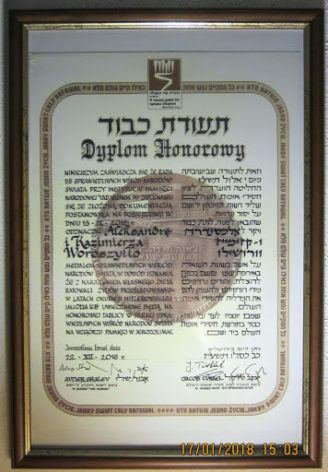 Yad Vashem diploma for Aleksandra and Kazimierz Woroszyłło." width="432" height="622" />
Yad Vashem diploma for Aleksandra and Kazimierz Woroszyłło." width="432" height="622" />Yad Vashem diploma for Aleksandra and Kazimierz Woroszyłło.
 A place in Krzysztof Wacławski’s room commemorating the heroic grandparents Aleksandra and Kazimierz Woroszyłło." width="452" height="603" />
A place in Krzysztof Wacławski’s room commemorating the heroic grandparents Aleksandra and Kazimierz Woroszyłło." width="452" height="603" />A place in Krzysztof Wacławski’s room commemorating the heroic grandparents Aleksandra and Kazimierz Woroszyłło.
 The house at 2/4 Bednarska Street where the Woroszyłlo family hid Elżbieta Lewin." width="696" height="522" />
The house at 2/4 Bednarska Street where the Woroszyłlo family hid Elżbieta Lewin." width="696" height="522" />The house at 2/4 Bednarska Street where the Woroszyłlo family hid Elżbieta Lewin.
Another thing. When we were going to the meeting at my apartment in Ursynów, we were driving along Puławska Street. Then Elżbieta pointed out the house where her family was hiding and said that she would come there with Aleksandra to remember this place if she had been separated from her foster mother for some reason, to know where to look for the family. She was about 6 at the time and she would remember it for the rest of her life.
MH: Are you still in touch with Ms Elżbieta Lewin?
PK W: I am still in contact with Elżbieta Lewin. We send each other letters with photos and Christmas greetings. We call each other. On the other hand, I have constant contact with her partner Roki through the Facebook social networking site.
MH: Please tell me about the book „W getcie warszawskim” by Eugenia Szajn-Lewin.
PK W: Eugenia Lewin (Ewa) left the ghetto at the beginning of April 1943. She took her manuscript to the Aryan side and placed it in a hiding place under the floor in an apartment on Puławska Street, where she was hiding with her family. Shortly after the Germans had left Warsaw, Maria returned to Puławska Street and took out her sister’s manuscript.
„In the Warsaw Ghetto” is an important literary document. The names of the heroes and all the events described in the book are true. The text was written in the ghetto between July 1942 and April 1943. It tells about the great liquidation of the Warsaw ghetto, work in KG Schultz’s shed, about blockades and transports, about the first shots on April 18, 1943. About Jewish life and Jewish death in that Warsaw.
Eugenia Lewin, née Szajn, was born in Łódź in 1909. After graduation, in the gymnasium. Eliza Orzeszkowa studied Polish studies in Warsaw. She graduated from the Higher School of Journalism in Warsaw. In 1935 she married Eng. Lewina and lived in Łódź until the outbreak of the war. In November 1939, Eugenia Lewin with her husband and one-year-old daughter, Elżbieta, her parents Leon and Hanna Szajn, and her sister Maria Private, with her husband and son left for Warsaw.
She published her articles and reports under the pseudonym of Eugenia Świetlicka, among others, in „Last News” and „Kurier Warszawski”. As (Giza Szen published her only novel, Life Again, in the Hoesicka publishing house. In November 1939, Eugenia Szajn Lewin’s family moved to Warsaw. The author survived the ordeal of the Warsaw Ghetto, which she managed to leave at the beginning of April 1943.
Maria Line, Eugenia’s twin sister, was an attorney in Łódź before the war. She spent the time of the Warsaw ghetto together with Eugenia, who appears in the book under the name of Ewa. Maria is one of the heroines of this story. After the war, Maria moved to Israel in Tel Aviv.
 Eugenia Szajn Lewin" width="443" height="686" />
Eugenia Szajn Lewin" width="443" height="686" />Eugenia Szajn Lewin
Here is a fragment of the book „In the Warsaw Ghetto” describing the rescue of her daughter Elżbieta and her son, Rysio, from the ghetto:
“The matter of children is not easy. It’s especially hard with a boy. After all, it has its Jewish stigma. Poles are afraid. You cannot send only Elżunia, you also need to find a place for Rysio. Artur and Tadeusz use their acquaintances and relations with Poles. They communicate by phone with the Aryan side.
– Then send both packages. The goods will be unloaded somehow. Will they be together? Careful answer. – The package has its place. Together, we’ll see each other later. Where? To whom? It is not known. It is therefore necessary to send children from the closed and closely guarded ghetto. Things for children, valuable items, money … You have to pay in advance, until the end of the war, because if the parents die … And again, Artur and Tadeusz 'send parcels’, discuss the issue of leaving the children with the head of the facility located outside the ghetto, after Aryan side. The children, Ryś and Elżbieta, are bitten by worms, covered with ulcers, and gaunt. There is already a place for them about which nothing is known exactly.
Ewa leads Elżunia to the hairdresser to lighten her hair. He plaits Elżunia into braids, gives beads around her neck. Artur takes his daughter by the hand, Marysia takes Ryszard and they leave in the morning. They leave with the facility employed on the Aryan side. They walk with a group of workers in the middle of the road. Eve follows them from a distance. She looks at the white, bare legs of Elżunia and the swarthy calves of Rysio, as if she would not see them anymore. I want to remember this lively and impatient step of Rysio, who knows and understands everything and is very curious about his new life. And also those unconscious steps by Elżnia, in her oversized, childish shoes. Tears are pouring from Eve’s eyes. Will he see her again?
The day passes like a dream, automatically. Ewa hides from the blockade. He hears constantly cries and screams. Her thoughts are far from the tragedy of the ghetto. He focuses all his will on the desire that the children only get to their destination. „
MH: Are you interested in genealogy? If so, where did this interest come from?
PK W: I’ve been interested in genealogy since 2001. I was inspired by my father Tadeusz, who made lists of all his relatives and put on them the dates of birth and death, as well as their place of residence. We also cared for family graves together.
He talked about family history and various interesting events. An interesting treasury of factual knowledge about the family was his sister Sabina. On the other hand, on the part of my mother, nee Saar, her sister Kazia stood out with extraordinary knowledge. I managed to persuade her and she wrote „The History of the Saar Family” in her notebook. However, I rewrote it in the Word text editor and completed it with photos. Thanks to this, the entire family received a compendium of knowledge in an electronic version. My aunt also received a printed copy and was delighted in the last months of her life.
MH: Do you have a family tree of the family?
PK W: I have had a family tree of the family on the My Heritage website since November 25, 2010. I am the administrator of the „Wacławski family website” tree.
It is a fascinating job. Unfortunately, I got stuck in my Wacławski branch in 1846, when my great-great-grandmother Julia Wacławska was born. I only know that she was a maid in the house at 50 Freta Street (Gleich’s tenement house) on 13.11. 1866 gave birth to my great-grandfather Alexander Julian. Unfortunately, so far I have not been able to find the baptism or death certificate of Julia. One unconfirmed trail found on the Genealodzy.pl website leads to Żabieniec, a town near Warsaw. And that has been my concern for several years.

